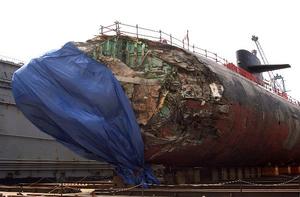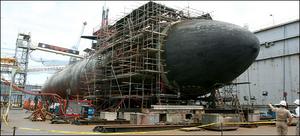May 17, 2005
The Submarine San Francisco
I had written about her collision with an uncharted undersea mountain before here, here and here. The last entry has this photograph of it sitting in drydock at the Guam naval Base:
Click for full-size Image

Click for full-size Image
Adrift 500 Feet Down, a Minute Was an EternityThe NY Times article also goes into the crash and why this could have happened:
Blood was everywhere. Sailors lay sprawled across the floor, several of them unconscious, others simply dazed. Even the captain was asking, "What just happened?" All anyone knew for sure was that the nuclear-powered attack submarine had slammed head-on into something solid and very large, and that it had to get to the surface fast.
In the control room, a senior enlisted man shoved the "chicken switches," blowing high-pressure air through the ballast tanks to force the vessel upward. Usually, the submarine would respond at once. But as the captain, Cmdr. Kevin G. Mooney, and top officers stared at the depth gauge, the needle refused to budge.
Moments before, they had been slipping quiet and fast through the Pacific. Now, they were stuck, more than 500 feet down.
Ten seconds passed. Then 20, 30.
"I thought I was going to die," Commander Mooney recalled.
It would be close to a minute, but an excruciatingly long minute, before the submarine's mangled nose began to rise, before the entire control room exhaled in relief, before the diving officer, Chief Petty Officer Danny R. Hager, began to read out a succession of shallower depths.
"I don't know how long it was," Chief Hager said, "but it seemed like forever."
Last week, Navy investigators reported that a series of mistakes at sea and onshore caused the 6,900-ton submarine, the San Francisco, to run into an undersea mountain not on its navigational charts. One crewman was killed, 98 others were injured, and the captain and three other officers were relieved of their duties as a result of the Jan. 8 crash, one of the worst on an American submarine since the 1960's.
But what is becoming clear only now, from the first interviews with Commander Mooney and 15 other officers and enlisted men, as well as a review of Navy reports, is how much worse it nearly was, and how close the San Francisco came to being lost.
To avoid detection, submarines travel silent and largely blind, relying heavily on charts, and their interpreters, to navigate the undersea landscape. The meeting of this submarine and that mountain beneath the Pacific was in many ways a stroke of hauntingly rare bad luck: everyone relied on the one chart, from a panoply of them, that lacked even a hint of the looming danger. But the submarine's fate was also the result of a confluence of simple shipboard errors.And the seamount in question:
The Navy has placed the blame on the captain and the crew, and Commander Mooney says, "I accept full responsibility." He acknowledges several critical mistakes, including going too fast, taking insufficient depth soundings and failing to cross-check the route with other charts.
Looking at a picture of that moment, Commander Mooney speaks with pride of the way his crew brought the boat home. But an image discovered on the voyage back also remains seared in his mind, he says, one that helped seal his dismissal and spark broader questions about the Navy's navigational training and support.Emphasis mine -- cartography problem. Part of the responsibility of being Captain is that you are ultimately responsible for your ship and anything that may happen to her -- still, it's a shame that the Navy will lose the skills of this excellent Officer... Posted by DaveH at May 17, 2005 1:10 AM
That image is a small, light-blue circle on a white background. It signifies a potential hazard two to three miles from where the San Francisco crashed - close enough, Commander Mooney says, that if he had known about it, he would have tried to skirt the area or asked for a new routing. Charting experts now believe that hazard was the mountain, and that its location was imprecisely reported in the days before satellites made navigational fixes more precise.
Commander Mooney said he first heard about the hazard from his boss onshore a few hours after the grounding. It is, in fact, on every chart of the area except for the one that the boat was using - the one that usually provided the most detailed picture of the seabed contours.
Comments
Post a comment